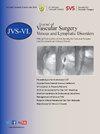射频消融与氰基丙烯酸酯封闭治疗孤立性小隐静脉功能不全的长期疗效比较研究。
IF 2.8
2区 医学
Q2 PERIPHERAL VASCULAR DISEASE
Journal of vascular surgery. Venous and lymphatic disorders
Pub Date : 2025-09-12
DOI:10.1016/j.jvsv.2025.102317
引用次数: 0
摘要
背景:静脉内消融被广泛推荐用于治疗小隐静脉(SSV)功能不全,但孤立性SSV (iSSV)反流的研究仍然较少,特别是在比较环境中。本研究旨在评估射频消融和氰基丙烯酸酯封闭治疗iSSV功能不全患者的临床和解剖学结果。方法:采用前瞻性收集的两种方式的iSSV患者数据进行回顾性研究。术前超声检查解剖形态及反流。消融策略根据解剖变化量身定制。一些患者在6个月、12个月和24个月时进行双工超声随访(中位随访12个月,范围6-24个月)。结果包括手术时间、静脉闭塞率、症状改善、并发症、静脉临床严重程度评分(VCSS)和阿伯丁静脉曲张问卷(AVVQ)的变化。结果:306例患者共379条肢体接受治疗(射频消融术85例,氰基丙烯酸酯封闭术294例)。氰基丙烯酸酯封闭术比RFA手术时间更长(P < 0.001),随访时闭塞率更高(99.3%比91.8%,P = 0.006)。两组VCSS、AVVQ和疼痛评分均有显著改善(P < 0.001)。射频消融术治疗的两肢发生腓肠神经损伤,氰基丙烯酸酯治疗的两肢未发生腓肠神经损伤。两组血栓延伸至深静脉无显著性差异。结论:射频消融术和氰基丙烯酸酯封闭术治疗iSSV功能不全是安全有效的。针对个体静脉解剖进行量身定制的治疗可以改善结果并减少并发症,如腓肠神经损伤。本文章由计算机程序翻译,如有差异,请以英文原文为准。
Long-term outcomes of radiofrequency ablation versus cyanoacrylate closure for isolated small saphenous vein insufficiency: A comparative study
Background
Endovenous ablation is widely recommended for treating small saphenous vein (SSV) insufficiency, but isolated SSV (iSSV) reflux remains less frequently studied, especially in comparative settings. This study aimed to evaluate the clinical and anatomical outcomes of radiofrequency ablation (RFA) and cyanoacrylate closure (CAC) in patients with iSSV insufficiency.
Methods
A retrospective review was conducted using prospectively collected data from patients undergoing either modality for iSSV. Preoperative duplex ultrasound examination assessed anatomical patterns and reflux. Ablation strategies were tailored to anatomical variations. Follow-up duplex ultrasound examinations were performed at 6 months, 12 months, and up to 24 months in some patients (median follow-up, 12 months; range, 6-24 months). Outcomes included procedure time, vein occlusion rate, symptom improvement, complications, and changes in the Venous Clinical Severity Score and Aberdeen Varicose Vein Questionnaire.
Results
A total of 379 limbs in 306 patients were treated (85 with RFA and 294 with CAC). CAC had a longer procedure time than RFA (P < .001) and a higher occlusion rate at follow-up (99.3% vs 91.8%; P = .006). Both groups showed significant improvement in Venous Clinical Severity Score, Aberdeen Varicose Vein Questionnaire score, and pain scores (P < .001). Sural nerve injury occurred in two limbs treated with RFA and none with cyanoacrylate. Thrombus extension into the deep vein occurred in both groups, without a significant difference.
Conclusions
Both RFA and CAC were effective and safe for treating iSSV insufficiency. Tailoring treatment to individual venous anatomy may improve outcomes and minimize complications such as sural nerve injury.
求助全文
通过发布文献求助,成功后即可免费获取论文全文。
去求助
来源期刊

Journal of vascular surgery. Venous and lymphatic disorders
SURGERYPERIPHERAL VASCULAR DISEASE&n-PERIPHERAL VASCULAR DISEASE
CiteScore
6.30
自引率
18.80%
发文量
328
审稿时长
71 days
期刊介绍:
Journal of Vascular Surgery: Venous and Lymphatic Disorders is one of a series of specialist journals launched by the Journal of Vascular Surgery. It aims to be the premier international Journal of medical, endovascular and surgical management of venous and lymphatic disorders. It publishes high quality clinical, research, case reports, techniques, and practice manuscripts related to all aspects of venous and lymphatic disorders, including malformations and wound care, with an emphasis on the practicing clinician. The journal seeks to provide novel and timely information to vascular surgeons, interventionalists, phlebologists, wound care specialists, and allied health professionals who treat patients presenting with vascular and lymphatic disorders. As the official publication of The Society for Vascular Surgery and the American Venous Forum, the Journal will publish, after peer review, selected papers presented at the annual meeting of these organizations and affiliated vascular societies, as well as original articles from members and non-members.
 求助内容:
求助内容: 应助结果提醒方式:
应助结果提醒方式:


